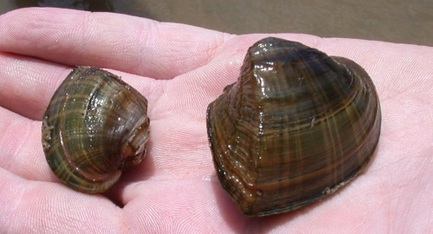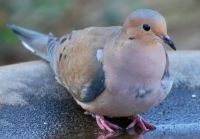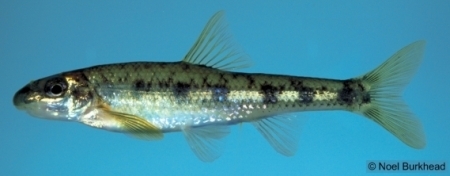|
New hope for Altamaha arcmussels
Jackson Lake discovery extends range, adds haven

State mussel specialist Jason Wisniewski admits that working with freshwater mussels can be “pretty depressing.”
These underappreciated bellwethers of water quality rank among North America's most imperiled wildlife. By some estimates, as many as two-thirds of native mussel species on the continent are considered endangered, threatened or of special conservation concern.
Imagine, then, Wisniewski’s pleasant surprise this summer when he and fellow staff with the Georgia Department of Natural Resources’ Nongame Conservation Section found Altamaha arcmussels at Jackson Lake – 100 miles north of the most northern site the mussels had been documented before. And not just one arcmussel, a species listed as threatened in Georgia.
Following up on a property owner’s call to UGA professor Dr. Robert Bringolf, Wisniewski, technician Deb Weiler and interns Lucas Hix and Chris Yates discovered live arcmussels – big ones – and shells in coves around Jackson. The 4,700-acre Georgia Power lake sits between Atlanta and Macon.
The reservoir revelation not only extends the Altamaha arcmussel’s range north, “(It) gives us hope that this species is really a lot more common than we thought,” Wisniewski said.
There are other reasons for that hope, so uncharacteristic for a mussel.
-
Surveys (including the search pictured below) have documented more arcmussels than expected on the mainstem Altamaha, the species’ historic grounds.
- Ongoing analysis of similar mussels Wisniewski and others found in Clarks Hill Reservoir and the Ogeechee River suggests that Altamaha arcmussels may also occur in the Savannah and Ogeechee river basins, further expanding their range.

“A lot of people thought the arcmussel was as rare as the (Altamaha) spinymussel,” Wisniewski said, referring to the spiky mussel also endemic to the Altamaha and federally listed as endangered. “What we’ve found is that it’s nowhere near as rare.”
Jackson Lake could help keep it that way.
One of the state’s oldest reservoirs – Lloyd Shoals Dam was built in 1910 – Jackson drains into the Ocmulgee, which joins the Oconee River to form the Altamaha. According to records, the arcmussel’s range was supposed to reach only as far north as Hawkinsville on the Ocmulgee.
Reservoirs are usually bad news for rare aquatic species. But they can provide stable habitat for some mussels. Jackson may be a haven for arcmussels. Wisniewski judged the population there “relatively dense,” with mussels that “appear to be growing extremely fast.”
He sees the work documenting the Altamaha arcmussel’s status as affirming State Wildlife and Tribal Grants. The federal program helps states conserve wildlife so listing is not required, a more effective and less costly approach to conservation. With the arcmussel, said Wisniewski, “it seems like we may be getting close to that goal.”
More on mussels
-
Mussels are members of the world’s second-largest group of animals – mollusks.
- The southeastern U.S. supports the most diverse mussel fauna in North America. Georgia has some 126 species.
- The Altamaha arcmussel was considered decades ago for federal listing under the Endangered Species Act. It is one of hundreds of animals and plants the U.S. Fish and Wildlife Service has agreed to decide whether to list or not by 2018.
 Out my backdoor
Who wins gold in my yard?
By Terry W. Johnson
The XXX Olympic Games showed us some of the world’s greatest athletes. Which got me to wondering: How would their athletic feats compare to some of the animals that live outside my back door?
Some of the most breathtaking Olympic events involve speed. The fastest Olympians can reach about 28 mph. (Mere mortals like us rarely break 18 mph.)

You’ll find it comforting that the American cockroach, the fastest insect likely found your yard, can scurry across the ground at only 3.4 mph. That doesn’t sound like anything to brag about – until you consider that this universally disliked insect is moving at 50 body lengths per second. That’s comparable to a human running 210 mph!
Other speedsters include red foxes (above), mourning doves (left) and dragonflies, while the best jumpers vary from fleas to white-tailed deer, and the top weightlifters …
Well, you'll have to read on here to find out which animals would be favored for a medal in your backyard!
Terry W. Johnson is a former Nongame program manager with the Wildlife Resources Division and executive director of TERN, the Nongame Conservation Section’s friends group. Terry's “Out my backdoor” columns are archived here.
Also check out this ABC News video comparing the speeds of cockroaches and 1996 Olympic track stars.
|
Noteworthy
Gopher tortoises relocated to Yuchi Wildlife Management Area apparently like their new home (“Study keys on keeping tortoises put,” June 29). In six weeks since their silt-fence pen at the Burke County WMA was removed, none of the tortoises tracked by transmitters have moved more than 1.5 kilometers (just under a mile) and most have dug burrows, according to The Orianne Society’s Javan Bauder, leader of the State Wildlife Grants-funded project.
Some 100 black-bellied whistling-ducks were banded for the first time last month at Altamaha Waterfowl Management Area, work done by Wildlife Resources Division staff. Data from band recoveries will be used to better understand the growing population of black-bellied whistling-ducks along Georgia’s coast.
Catch rates of invasive flathead and native channel catfish both declined 30 percent on the Altamaha River this year, according to sampling by the Wildlife Resources Division’s Fisheries Management Section. The drop is attributed to severe drought, although blue catfish fared better, with catch rates for the non-native species increasing slightly.
Fish sampling on the Toccoa River in Union County netted eastern hellbenders and blotched chubs ( see below). But DNR Stream Survey Team and Nongame Conservation Section staff also made an unwanted catch: 15 bandfin shiners, a Tennessee River drainage native likely introduced as bait into the Toccoa from adjacent drainages in north Georgia.

Project WILD continues to grow in Georgia, with 20 workshops scheduled, varying from programs designed for facilitators to Flying WILD educators. These events follow this summer’s Outdoor Wildlife Leadership School and Teacher Conservation Workshop.
What bird dives 150 feet to scour the ocean floor for food? The majestic cormorant -- and this video of one with a camera attached to its back takes you along for the dive off the coast of Argentina.
|
Correction: The number of sea turtle strandings in 2011 was misstated in the July 30 Georgia Wild. The total given – 134 – was only through the 30th week of that year.
Upcoming:
- Aug.
18 and 27: Coastal Georgia Cooperative Invasive Species Management Area
citizen scientist training for detecting, reporting invasive
species: 9 a.m. Aug. 18, Susan Shipman Environmental Learning Center, DNR
Coastal Resources Division, Brunswick. Also: 10 a.m. Aug. 27, UGA
Bamboo Farm and Coastal Gardens, Savannah. Contact: Eamonn
Leonard, eamonn.leonard@gadnr.
- Sept. 20: Agroforesty & Wildlife Field Day, UGA Griffin Campus.
- Oct.
4-6: Gopher Tortoise Council annual
meeting, Kirbo Center at Bainbridge College
in Bainbridge.
- Nov.
8: Georgia Exotic Pest Plant Council annual
meeting and conference, Stuckey Conference Center, UGA Griffin
Campus.
Headlines
Rare species profile:
Blotched chub
 Blotched chubs, state-listed in Georgia as endangered, are silvery minnows with
big, upward-directed eyes and six to nine rectangular-shaped blotches along the
mid-side of their bodies. These chubs eat mainly periphyton and aquatic insect larvae
and live mostly in riffles and runs with coarse, rocky substrates in moderate-sized
mountain creeks and small upland rivers. The species is found in the Tennessee and
Cumberland river drainages in several southeastern states, but primarily in Tennessee.
In Georgia, blotched chubs have been documented in the Toccoa, Nottely and Hiawassee
river systems in Fannin, Union and Towns counties. Dependent on good water quality and
fast-water habitats, this small fish faces threats from impoundments that limit the needed
Credits
** Masthead: Black-bellied whistling duck. Robert Burton/U.S. Fish and Wildlife Service
** Altamaha arcmussels. Deb Weiler/Ga. DNR
** Grubbing for mussels on the Altamaha River. Rick Lavender/Ga. DNR
** Red fox. U.S. Fish and Wildlife Service
** Mourning dove. Terry W. Johnson
** Blotched chub. Noel Burkhead

Give wildlife a chance!
The Nongame
Conservation Section of Georgia DNR receives no state funds to
conserve nongame wildlife, native plants and natural habitats. Instead, we
depend on contributions, grants and fundraisers, such as the eagle and
hummingbird license plates.
How can you help?
Learn more about the Nongame Conservation Section in our annual
report.
|